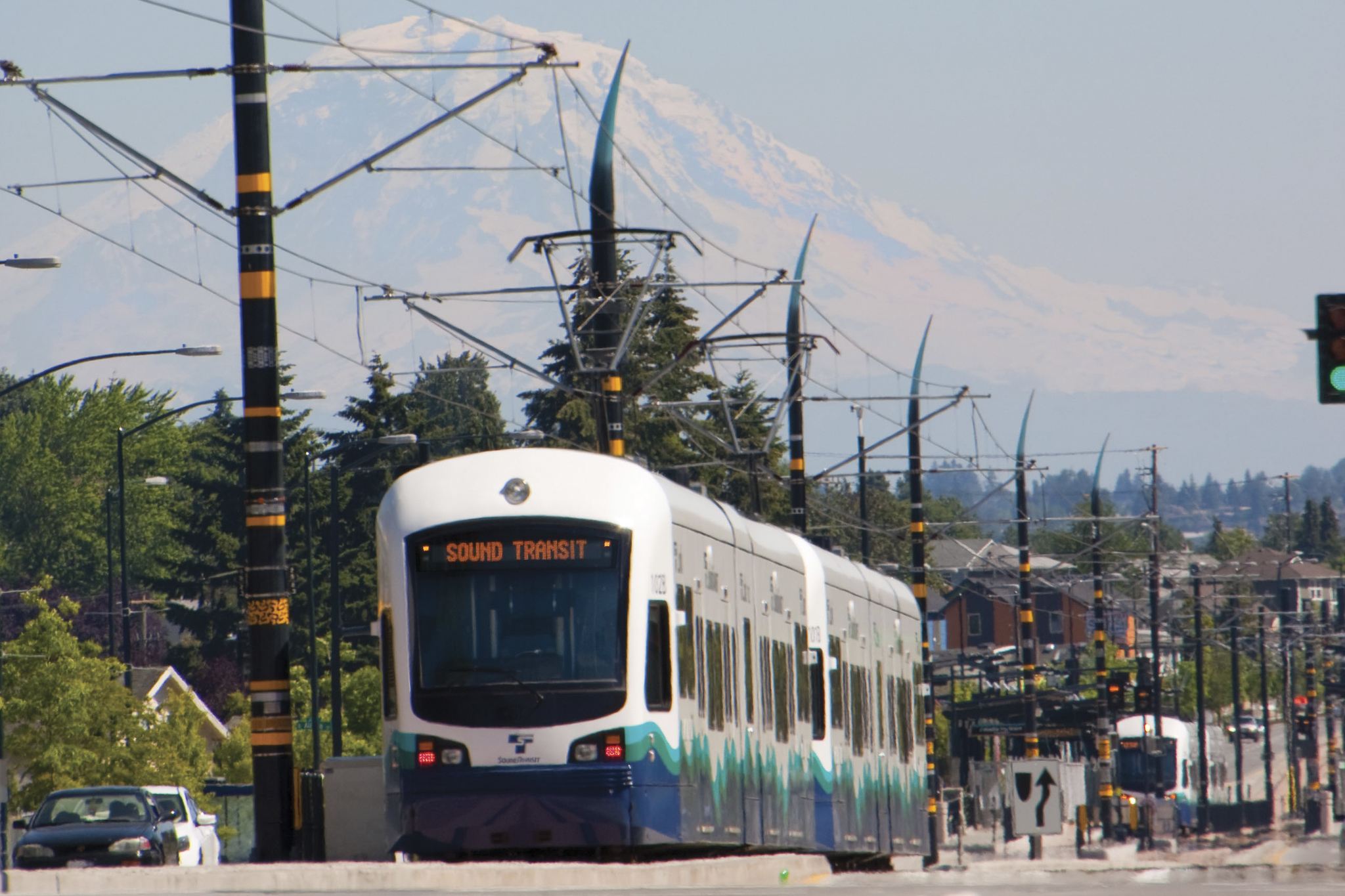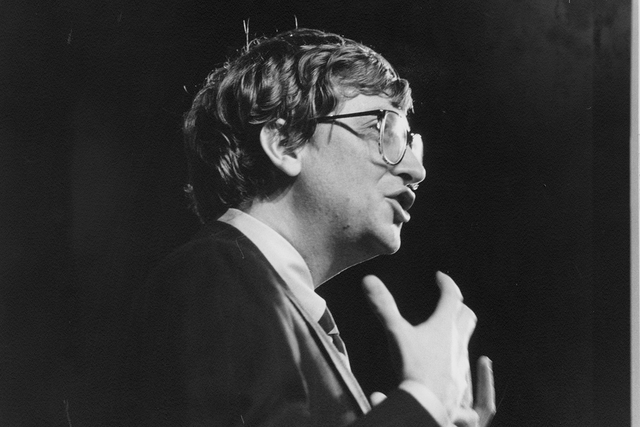On November 8, Seattle-area voters will decide on the biggest ask any agency has ever put before them: Sound Transit’s $54 billion plan to lay light-rail tracks to Bellevue, Redmond, Issaquah, Everett, Tacoma, Ballard, and West Seattle, and provide new express-bus lines and commuter-rail stations.
Set aside for a moment the big-picture issues—whether pricey rail is the best way to connect those destinations, and Sound Transit’s messy history of cost overruns, years-long delays, and ridership lagging far behind projections, respectively re-spun as “under budget, on time” and growing like Topsy. Follow instead Sound Transit’s history in Rainier Valley, and consider one small piece of unfinished business that ST3 would complete—a focal point for weighing the agency’s trustworthiness and commitment to social justice, the enormous trust it’s asking voters to place in it, and how much transit access can mean to a community.
From 1995 to 2000, as the Link light rail route from Northgate to SeaTac took shape, one point flickered off and on like a dying bulb: a station at Martin Luther King Way and South Graham Street, at the heart of the valley. Finally, as budgets tightened and other issues loomed, the agency deferred and then effectively killed the station.
Now, thanks to community persistence, the Graham station is back in ST3. That’s the good news. Not so good: Sound Transit estimates that, with all the additional infill costs, the station in which it opted not to invest $5.2 million 16 years ago will now cost $65 to $70 million. And residents will have to wait 15 more years for it, if it ever gets built. Some, remembering the city’s and transit agency’s long record of promises broken in southeast Seattle, fear that might not be such a done deal.
The Sound Move ballot measure that voters approved in 1996 did not include a station at Graham. But in December 1998, the plan’s environmental-impact statement identified Graham as one of three “potential” stations, along with North Capitol Hill and Beacon Hill, along the route that was finally chosen. Two months later the Sound Transit Board identified its “preferred route” for environmental review: no North Capitol Hill station; Beacon Hill only “if funding is available”; Graham for sure.
Compelling arguments could be made for all three stations, but the first two would cost more, since they would be underground. Graham Street sits midway between two stations 1.7 miles apart: the Columbia City station at Edmunds Street and another one at Othello Street. Elsewhere in SoDo and the Rainier Valley, stations are placed about one mile apart. The standard measures of how far people will walk to catch transit are a quarter-mile for buses, a half-mile for rail. To omit the Graham station would leave a glaring gap and effectively deny rail access in the middle of the corridor.
It would also cut off several high-traffic community institutions: a shopping center then anchored by southeast Seattle’s largest Asian supermarket, Viet-Wah; Chua Co Lam, the region’s largest Vietnamese Buddhist temple; the Department of Social and Health Services Rainier service center; what was then the Seattle Schools’ districtwide ESL secondary school (now Aki Kurose Middle School); and the Filipino Community Center, a regional hub for seniors and others. On weekends, especially Buddhist holidays, worshippers, shoppers, and diners would fill the temple and Asian Plaza parking lots to bursting.
Then, in November 1999, the Graham station got unpreferred. The ST board adopted a plan that deferred it and the stadium and Beacon Hill stations until some future date. Residents were dismayed, but they were occupied with a bigger issue: For months they had pled and petitioned to get the rail line to run underground in the South End, even proffering an alternate cost estimate for tunneling from the contractor who dug the I-90 tunnel under Mount Baker. They feared that the chosen, cheaper option—surface tracks down MLK Way—would chop the neighborhood in two, spread blight, block auto access, and choke off local businesses. (Those fears have to varying degrees been borne out, though noise and pedestrian casualties have proven much less than residents feared.)
The valley’s mostly minority residents also saw one more in a long line of disparities in the allocation of public services—from mailboxes and ballot drop-offs to schools, sidewalks, and police manning—between their neighborhood and whiter, more affluent areas to the north. They got surface rail; the U District and Roosevelt would get tunnels and Tukwila and SeaTac elevated tracks. (The disparity continues. Sound Transit will run elevated rather than surface rail up industrial 15th Avenue West to Ballard and to most of the suburban destinations in ST3.)
In 1999, Sound Transit justified this disparity by arguing that “many of the benefits of a new light-rail system, including travel time savings and improved access to jobs, are proportionally greater [emphasis in original] for Rainier Valley residents than for residents anywhere else.” In other words, you should be glad to trade the disadvantages you now have for this new disadvantage.
“SOV” (Save Our Valley) signs sprouted like recycle bins on collection day. But as expected, the Sound Transit board opted for a surface line down MLK Way. The SOV group sued, but their case was dismissed, and the resistance collapsed.
“What ultimately broke our alliance and power structure was that Sound Transit picked off groups within it,” says Ray Akers, a veteran Columbia City realtor active in the SOV effort and negotiations with the agency. “We found them absolutely unscrupulous. They seemed to suck up every politician who touched them, like glue.”
As originally drawn, the route would clip the Filipino Community Center, a key player in the resistance. Sound Transit at first offered chump change to compensate the damage, recalls Akers, as it did to many immigrant landowners whose property it condemned for the rail route. Then, when the Filipino organization resisted, Sound Transit “said we’ll buy you a whole new building, and peeled them off.” Emma Catague, a former boardmember at the Filipino center, recalls the negotiations differently: Sound Transit never offered more than chump change, she says, and many in the community still opposed the surface route. But Columbia City resident George Curtis, who spearheaded the SOV campaign, recalls “an architectural drawing—a color brochure—of a brand-new center” that Sound Transit dangled.
After the resistance collapsed, Sound Transit announced it had resurveyed and discovered it could nudge the tracks over and spare the old building. The Filipino community still occupies it.
Danh Nguyen, a volunteer at Chua Co Lam, says people at the temple recall a similar bait-and-switch. They were led to believe a pedestrian bridge would be erected over Graham Street and the tracks. It wasn’t (and the trains’ overhead power lines might have made it infeasible anyway). “If they don’t have a walking bridge there, we want a train station!” he says.
Sound Transit and the city also promised the valley compensation for the hardship and disruption inflicted by construction, street widening, and property condemnations. They agreed to a $50 million Rainier Valley Development Fund for businesses forced to relocate or close temporarily. The community wanted $250 million, says Akers, but was glad for the other benefits promised: new sidewalks, curbs, decorative lighting, and landscaping along MLK and Columbia City’s gateway streets, Edmunds and Hudson—and a station at Graham Street after all.
One by one, most of those benefits shrank or disappeared. The community held onto the development fund, which has since been a lifeline for many small businesses, resisting city efforts to claw back control of it. The reconfigured MLK Way inevitably got new sidewalks, though because of space constraints they’re narrower than usual for major arterials. But pedestrians still stumble on the old pavers along Edmunds and Hudson Streets. And the station receded into a dim someday that became, effectively, never.
In May 2000 the ST board voted not to acquire land for a future Graham station; its Rainier Valley Transit Advisory Council and the Seattle City Council had already recommended against it. Sound Move faced cost overruns that would eventually total 86 percent, according to The Seattle Times’ recent calculation, and banking land meant more expense now for a conjectural future benefit. Folks in the valley were jaded and exhausted: “We just considered it another deceptive move by Sound Transit, which wasn’t totally unexpected,” says Curtis.
After the trains started running from Sea-Tac to Westlake in 2009, the missing Graham station ached like a phantom limb. In 2000, when it axed the station from its plan, Sound Transit declared that its ridership model showed that “most of the riders who would have boarded at this station would still ride light rail by boarding at either the South Edmunds Street station [one mile] to the north, or the South Othello Street station [three-quarters of a mile] to the south”—a surprising finding, contrary to general transit thinking, and to what seems to have happened. The narrow sidewalks along the reconfigured MLK do not now teem with seniors, grocery shoppers, and families with kids trudging back to the train after worshipping and shopping at Graham Street.
Sheila Burrus, the Filipino Community Center’s executive director, says the lack of rail access is a hardship that will only weigh heavier when the center completes a large senior-housing project. “This community is really dependent on transit,” she explains. “We have people coming from all over the place, from Kent, Renton, and North Seattle. Because of gentrification they are being pushed out beyond the boundary.”
“I hear a lot of people talking, ‘Why do they build a train station there and a train station there [he waves toward Othello and Columbia City] and no station here in the center?’ ” says Chua Co Lam’s Banh Nguyen.
When they voted not to bank land for a Graham station, the city and Sound Transit promised to provide the neighborhood “improved pedestrian, bicycle, and bus access” to the stations north and south. But aside from those new sidewalks along MLK, residents got mostly the opposite. No bike lanes appeared, and the narrower traffic lanes required to squeeze in the rail line made biking even more perilous. The tracks severed 40 of the 54 cross streets along the corridor, but did bring new traffic lights to several that remained.
Still, the community around Graham Street has suffered. The tracks down MLK and complementary lane barriers added on Graham Street blocked auto access to Asian Plaza from two directions. Last year Viet-Wah closed, saying it could not afford a rent increase. It was replaced by a California-based Filipino supermarket chain.
Worst of all, the Graham neighborhood actually lost its lifeline to downtown, the Route 42 bus, deemed redundant now that trains whizzed down MLK. Metro eventually reinstated service by extending another line.
Why was Sound Transit so determined to bypass Graham Street?
Realtor Akers thinks “there’s no station at Graham because on three corners you had a 7-Eleven, McDonald’s, and Union 76 station” where the station would go, and national brands extract high prices for their sites. 7-Eleven has since left, but Starbucks now occupies the fourth corner. Sheila Burrus hears grumbles about “payback” to the valley for resisting surface rail.
With the acknowledged costs for Sound Move’s light-rail component climbing from the $1.7 billion sold to voters in 1996 to $2.6 billion in 1999 and $3.6 billion in 2000, the agency wanted to trim where it could. And any station omitted would shorten Link’s embarrassingly long travel time to Sea-Tac Airport—five minutes longer than the express bus down the SoDo busway it supplanted, which actually stopped at the terminal. (Then-King County Councilmember Greg Nickels recalls only the cost savings, not the speed issue being discussed at Sound Transit board meetings.)
When the line opened in 2009, I asked several Sound Transit officials why it skipped Graham Street. “Distance between stations is only one thing to consider,” said one. “Bus access is another.” There were, and currently are, no connecting crosstown buses on Graham Street. “We looked at that,” said ST deputy executive director Ron Lewis, but a hypothetical Graham station “didn’t add ridership.” It would merely have served “the convenience of people already there.”
Translation: It didn’t offer the same prospects for transit-oriented development—in particular, publicly subsidized nonprofit development—as the Columbia City and Othello junctions. There, the Seattle Housing Authority had big plans to redevelop its Rainier Vista and Holly Park projects. SHA and its City Hall partners needed those stations to attract not only homebuyers but federal funding.
No such big guns demanded a Graham station. Still, there’s ample space for development there: sprawling parking lots plus a large vacant, blackberry-tangled parcel between McDonald’s and the temple. And there’s a hunger for transit that the trains shooting past have only whetted. Karen Uffelman was one neighbor who pined to ride the train; she might be able to jog to the Othello station, but “my toddler son certainly can’t.” An experienced campaigner, she began lobbying for a station. “I heard from more than one Sound Transit staffer it was never going to happen,” she recalls. So she turned to the city and county as well, with support from Puget Sound Sage, One America, the Filipino Community of Seattle, and about 20 other local groups and businesses. They staged tours and rallies at the site. She gathered 1,258 signatures on a change.org petition.
City Hall got the message first. Mayor Murray included $10 million toward a Graham station in last year’s $930 million Move Seattle transportation levy—and made the most of it. Though the station was about 1 percent of the total ask, it got marquee billing in Move Seattle’s language and promotion. Murray held a press conference at Graham and MLK to promote it.
In March Sound Transit assented and included the Graham Station in its updated ST3 plan, “responding to the community groundswell,” as spokesman Geoff Patrick puts it. Infill stations at Boeing Access Road and Northeast 130th Street also got the go. But the Graham Street station would not be built until 2036, near the end of the ST3 schedule, 12 years after new lines to Bellevue and Redmond and Kent and Federal Way, six years after the new West Seattle line, and 27 years after rail started running down the Rainier Valley.
The project, Patrick explains, is complex. The MLK corridor is too tight to allow building a station on new, parallel tracks while continuing to use the current tracks, an approach that has allowed Portland’s TriMet add infill stations for as little as $3 million. Sound Transit will have to close at least one track at a time while building at Graham.
Still, even at $65 million-plus, the Graham Station is a micro-project compared to the new rail lines. And new stations opening at Northgate in 2021 and Lynnwood in 2023 will increase passenger loads, meaning more disruption if Graham Station is built afterward.
Uffelman, Puget Sound Sage, and their allies pushed again. Sound Transit sped up the schedule for many ST3 components, moving Graham forward to 2031. They’ll keep pushing: “Fifteen years is too late for a station that should have been built in 2009,” says Sage policy analyst Giulia Pasciuto. Despite those criticisms, the 19-member coalition of community groups has come out strongly in favor of ST3.
Meanwhile, concerns about the station have arisen in the neighborhood itself—fears that it will fuel the sort of gentrification and displacement that are rampant in Columbia City and ramping up at Othello. After watching rents soar in Columbia City, George Curtis has changed his mind: “I’m no longer supportive of the Graham Street station.”
“Most of the people who work on this with me are immigrant and low- or low-middle-income,” says Uffelman, bristling at the gentrification charge. “There shouldn’t have to be a choice between public services and affordability. Otherwise you can say that in order to protect that neighborhood we should take away water and electricity. It seems possible to have both.”
And Graham Street is a place to prove that proposition true. Pascuito from Puget Sound Sage points to the Plaza Roberto Maestas development at the Beacon Hill station as an example of the sort of “community-driven affordable housing development” the Graham neighborhood needs.
The next step is obvious, in Uffelman’s view: “ST3 needs to pass or none of this is possible.” Forgive Sound Transit its past callousness and shortsightedness and give us our station.
Battered by the SOV wars, George Curtis remains skeptical. “The bottom line is money talks,” he says, and developers will inevitably put profits or federal housing subsidies above community interest. “With the size of that parking lot [awaiting redevelopment at Asian Plaza], anyone who thinks they’re going to be able to control that development is dreaming.” Likewise, he adds, for anyone who believes the station is sure to be built, even if Sound Transit lands its $54 billion “Hail Mary” on November 8. “You just don’t know what’s going to happen between now and 2031. The station disappeared once, and it may well disappear again.”
news@seattleweekly.com
CORRECTIONS This story has been edited to more clearly reflect Puget Sound Sage’s stance concerning ST3, as well as the nature of the proposition’s taxing scheme. Also, a previous version of the story used the term “trail of tears” inappropriately. We have replaced the offending text. We apologize for the usage.








